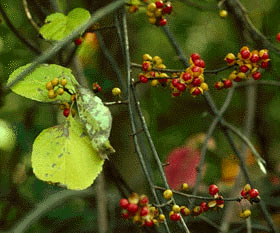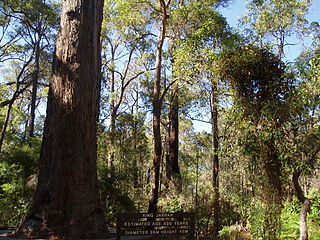
The Celastraceae are a family of 98 genera and 1,350 species of herbs, vines, shrubs and small trees, belonging to the order Celastrales. The great majority of the genera are tropical, with only Celastrus, Euonymus and Maytenus widespread in temperate climates, and Parnassia (bog-stars) found in alpine and arctic climates.

Mallee, also known as Roe Botanical District, is a biogeographic region in southern Western Australia. Located between the Esperance Plains, Avon Wheatbelt and Coolgardie bioregions, it has a low, gently undulating topography, a semi-arid mediterranean climate, and extensive Eucalyptus mallee vegetation. It has an area of 73,975.59 square kilometres (28,562.13 sq mi). About half of the region has been cleared for intensive agriculture. Recognised as a region under the Interim Biogeographic Regionalisation for Australia (IBRA), it was first defined by John Stanley Beard in 1980.

Jarrah Forest, also known as the Southwest Australia woodlands, is an interim Australian bioregion and ecoregion located in the south west of Western Australia. The name of the bioregion refers to the region's dominant plant community, jarrah forest – a tall, open forest in which the dominant overstory tree is jarrah.

The northern pipistrelle, also known as Koopman's or the mangrove pipistrelle, is a species of vesper bat found only in Australia. It is one of Australia's smallest bat species. On average, it weighs 3 g (0.11 oz).

Aphanopetalum is a genus of twining shrubs or vines in the family Aphanopetalaceae which are endemic to Australia.
This is a list of the terrestrial flora of the Houtman Abrolhos. Only vascular plants are listed — there have been some collections of mosses, liverworts and lichens from the Houtman Abrolhos, but no information has been published on these non-vascular groups.

Stackhousia is a genus of annual and perennial plants in the family Celastraceae that are native to Australia, New Zealand, Malesia and Micronesia. The genus was first described by James Edward Smith in Transactions of the Linnean Society of London in 1798.
Rhytidosteoidea is a superfamily of Temnospondyli, early amphibian species that existed during the Carboniferous, Permian, and Triassic periods. The taxon was established in 1965 to accommodate two new species of Deltasaurus, the author recognising an alliance with previously described genera.
Stackhousiaceae R.Br. is an obsolete family of plants, now merged into the family Celastraceae. When accepted, it comprised the following genera:
Stackhousia subterranea is a perennial herb species in the family Celastraceae. The species occurs in South Australia and Victoria and Tasmania

Stackhousia viminea the Slender Stackhousia is a common small Australian plant. It grows to 70 cm tall. The habitat is heathland, pastures, eucalyptus woodland and forest, usually in moist areas. It features attractive yellowish/red flowers. The specific epithet viminea refers to the slender stems. The genus is named after the botanist and artist, John Stackhouse.

Kumbadjena kaata is a species of velvet worm in the family Peripatopsidae. This species has 15 pairs of legs. The type locality is in Western Australia.
Kumbadjena shannonensis is a species of velvet worm in the Peripatopsidae family. This species has 15 pairs of legs. The type locality is in Western Australia.

Stackhousia clementii is a species of plant in the family Celastraceae and is native to Australia.
Stackhousia dielsii, commonly known as yellow stackhousia, is a species of plant in the family Celastraceae.
Stackhousia huegelii is a species of plant in the family Celastraceae.
Stackhousia pubescens, commonly known as downy stackhousia, is a species of plant in the family Celastraceae.

Stackhousia umbellata is a species of plant in the family Celastraceae.

The Cumberland Plain Woodland, also known as Cumberland Plain Bushland and Western Sydney woodland, is a grassy woodland community found predominantly in Western Sydney, New South Wales, Australia, that comprises an open tree canopy, a groundcover with grasses and herbs, usually with layers of shrubs and/or small trees.

Stackhousia spathulata, the coast Stackhousia is a species of plant in the family Celastraceae. A widespread small plant, found in heath and dry sclerophyll forest in sandy areas, often near beaches or lagoons in southeastern Australia. Growing to 50 cm tall. The specific epithet refers to the spoon shaped leaves.












